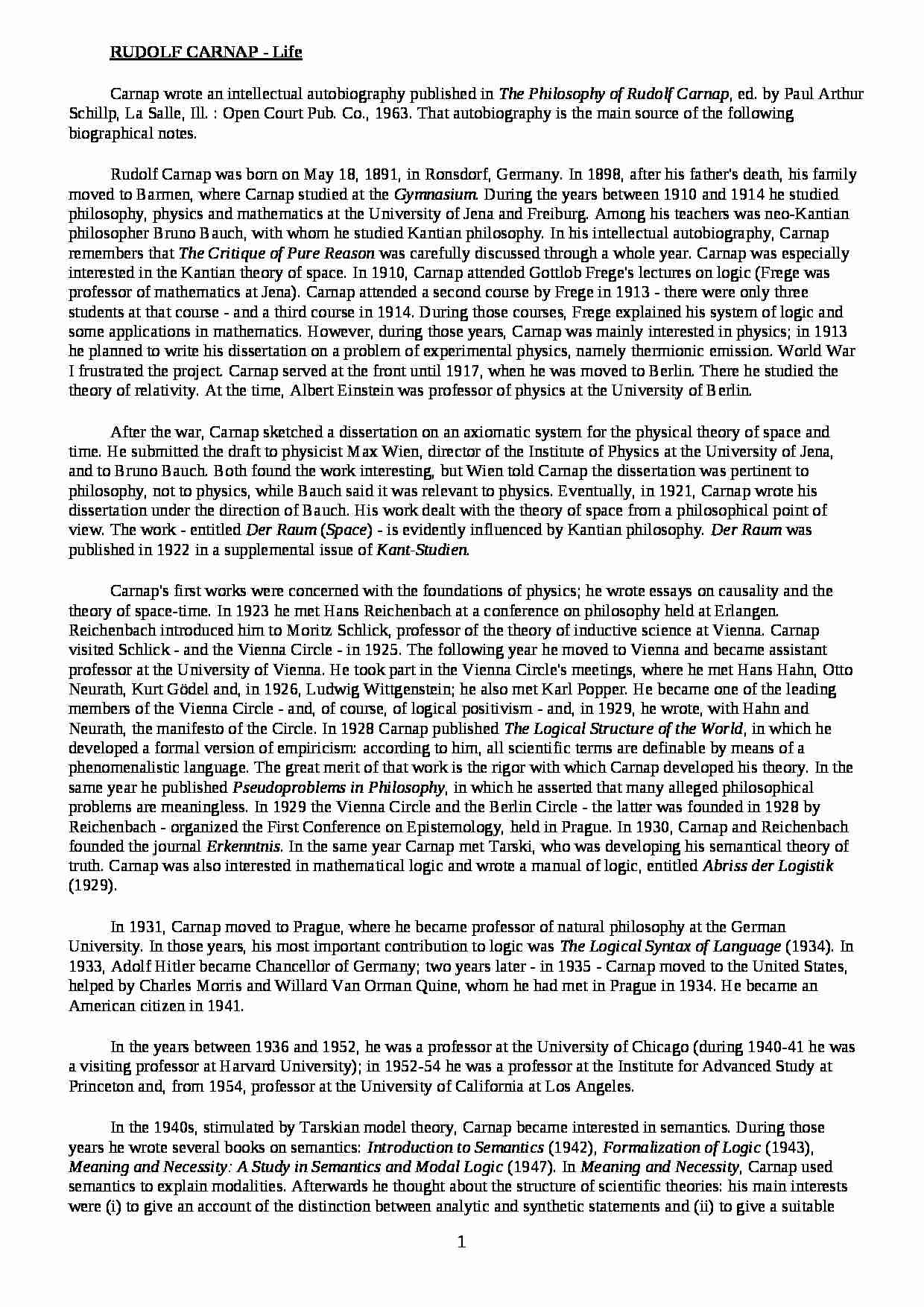RUDOLF CARNAP - Life Carnap wrote an intellectual autobiography published in The Philosophy of Rudolf Carnap, ed. by Paul Arthur Schillp, La Salle, Ill. : Open Court Pub. Co., 1963. That autobiography is the main source of the following biographical notes. Rudolf Carnap was born on May 18, 1891, in Ronsdorf, Germany. In 1898, after his father's death, his family moved to Barmen, where Carnap studied at the Gymnasium. During the years between 1910 and 1914 he studied philosophy, physics and mathematics at the University of Jena and Freiburg. Among his teachers was neo-Kantian philosopher Bruno Bauch, with whom he studied Kantian philosophy. In his intellectual autobiography, Carnap remembers that The Critique of Pure Reason was carefully discussed through a whole year. Carnap was especially interested in the Kantian theory of space. In 1910, Carnap attended Gottlob Frege's lectures on logic (Frege was professor of mathematics at Jena). Carnap attended a second course by Frege in 1913 - there were only three students at that course - and a third course in 1914. During those courses, Frege explained his system of logic and some applications in mathematics. However, during those years, Carnap was mainly interested in physics; in 1913 he planned to write his dissertation on a problem of experimental physics, namely thermionic emission. World War I frustrated the project. Carnap served at the front until 1917, when he was moved to Berlin. There he studied the theory of relativity. At the time, Albert Einstein was professor of physics at the University of Berlin. After the war, Carnap sketched a dissertation on an axiomatic system for the physical theory of space and time. He submitted the draft to physicist Max Wien, director of the Institute of Physics at the University of Jena, and to Bruno Bauch. Both found the work interesting, but Wien told Carnap the dissertation was pertinent to philosophy, not to physics, while Bauch said it was relevant to physics. Eventually, in 1921, Carnap wrote his dissertation under the direction of Bauch. His work dealt with the theory of space from a philosophical point of view. The work - entitled Der Raum (Space) - is evidently influenced by Kantian philosophy. Der Raum was published in 1922 in a supplemental issue of Kant-Studien. Carnap's first works were concerned with the foundations of physics; he wrote essays on causality and the theory of space-time. In 1923 he met Hans Reichenbach at a conference on philosophy held at Erlangen. Reichenbach introduced him to Moritz Schlick, professor of the theory of inductive science at Vienna. Carnap visited Schlick - and the Vienna Circle - in 1925. The following year he moved to Vienna and became assistant professor at the University of Vienna. He took part in the Vienna Circle's meetings, where he met Hans Hahn, Otto Neurath, Kurt Gödel and, in 1926, Ludwig Wittgenstein; he also met Karl Popper. He became one of the leading members of the Vienna Circle - and, of course, of logical positivism - and, in 1929, he wrote, with Hahn and Neurath, the manifesto of the Circle. In 1928 Carnap published
(…)
… University. In those years, his most important contribution to logic was The Logical Syntax of Language (1934). In 1933, Adolf Hitler became Chancellor of Germany; two years later - in 1935 - Carnap moved to the United States, helped by Charles Morris and Willard Van Orman Quine, whom he had met in Prague in 1934. He became an American citizen in 1941. In the years between 1936 and 1952, he was a professor…
... zobacz całą notatkę






Komentarze użytkowników (0)